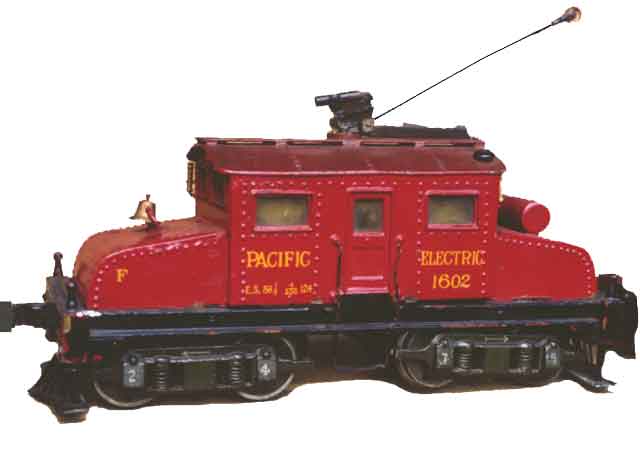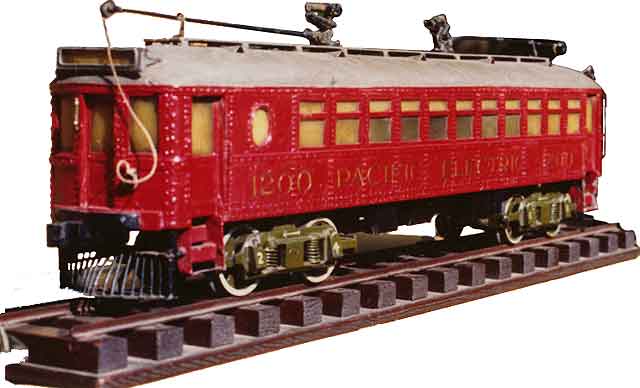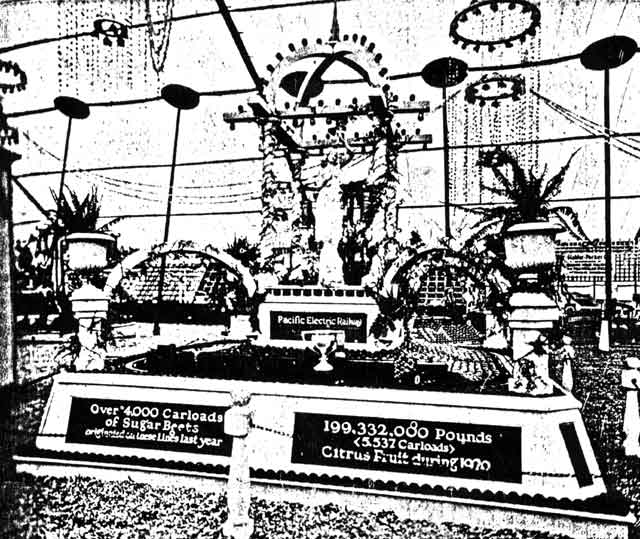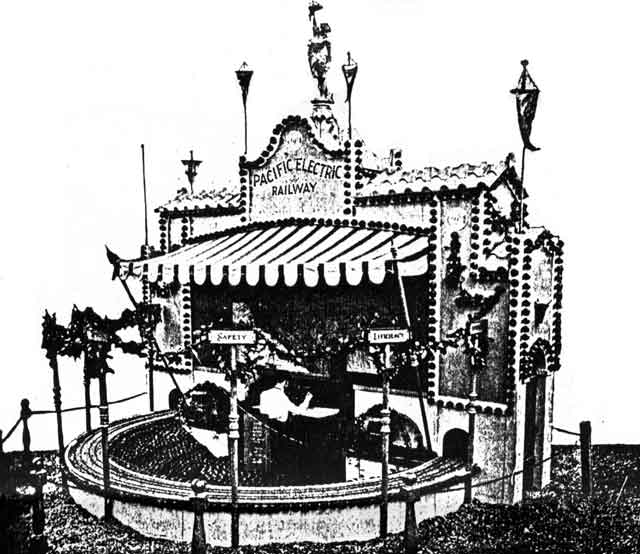THE ORANGE SHOW MODELS
by Charles Seims
|
I.C. |
Wood was the Pacific Electric’s Substation tender at Arcadia in 1915. Mr. Wood was one of many members of the company Electrical Department whose job was to tend the giant motor-generator sets that supplied 600 volts D.C. to energize the overhead trolley wire… it was a boring job.
The machinery itself needed little attention, which left Wood with a lot of time and little to occupy it. He was impressed by the massive 65-ton electric Baldwin-Westinghouse freight locomotives that had just been delivered new to the P.E. beginning in 1912. Wood decided that he would build an operating model of one of these locomotives that could be used for public relations for the railway.
Soon, bits of scrap metal began to clutter the workbench at Arcadia “sub.” Things like old bicycle spokes, parts from an old sewing machine, and channel iron from a discarded bed frame. Wood needed a small lathe for his model building, and built one by hand out of junk such as this.
After hundreds of hours of meticulous work, Wood completed his model of Pacific Electric locomotive #1602. In addition, he made some model box cars, refrigerator cars and a caboose for it to pull.

The train was a masterpiece. The locomotive body, was constructed from sheet brass, and was highly detailed, but it was in the trucks where Wood’s craftsmanship really came through. The wheels were brass castings, detailed even to the spokes for weight reduction. The side frames were also castings, highly detailed and cushioned by tiny springs. True to prototype practice, the electric motors were hung between the axles, not concealed within the cab as Lionel and Ives did it.
Eventually, Wood’s handiwork came to the attention of Paul Shoup, the P.E.’s president, and Harry Marler, the passenger traffic manager. They were delighted, and asked Wood if he would build a passenger car as well. They gave him access to all the railway's facilities, including a better lathe.

Wood returned to his workbench, and labored on this new project for nearly a year. His prototype was one of the brand new 1200 class steel interurban cars that had just been delivered to the P.E. by the Pressed Steel Car Company. The 1200’s are fondly regarded as the .finest electric interurban cars ever to serve on the P.E., and certainly Wood’s model did credit to the originals. The finished car is 31” long over the couplers, and meticulously detailed as was the electric locomotive. The sides are of brass, with real glass for the windows. Inside, five 110 volt Christmas tree bulbs provide interior illumination, while another tiny bulb serves as the car’s headlight.

This new masterpiece was completed around the beginning of 1917, just in time to be displayed at the National Orange Show in San Bernardino. The railway was justifiably proud of the models, and made every effort to show them off to the public. An operating layout was built for both the passenger and the freight train. It was displayed in bank lobbies and other public places in the World War I era, but most often the models made appearances at the various agricultural and citrus fairs that were popular at the time. Millions of Southern Californians saw the models operate at the yearly National Orange Show. Although the railway’s exhibit was changed every year, it typically consisted of the passenger and freight trains running on separate tracks around a display that resembled a giant papier-mâché wedding cake. The display was decorated with real or imitation oranges, plus photographs and facts about the vast Pacific Electric interurban network in Southern California.

First Honors Taken At Anaheim Show
Almost every time they were displayed, Wood’s models and the Pacific Electric display won a trophy or a prize. The displays were the subject of numerous magazine articles during the 1920’s. For instance, the railway claimed that during the Orange Show, the two trains ran a total of 700 miles on the little layout, and that the engines had a drawbar pull of 200 pounds.

Our Exhibit at the National Orange Show
The 1200-class passenger car and the freight train made frequent appearances at the National Orange Show and various other fairs until sometime in the mid 1930's. Old-timers recall them displayed (but not running) at the Pacific Electric Building at Sixth and Main Streets in Los Angeles. From this point, their history gets a bit murky and somewhat apocryphal.
It seems that Harry Marler, the railway’s Passenger Traffic Manager and later president, was very attached to the models. When he retired in the 1940’s he took them home with him as a memento of his lifelong career with the railway.
As the story has been related, Marler’s son owned a typewriter store which was having some financial difficulties in the late 1940's. Some of its assets went to auction in sealed lots. Purchaser of one of these lots was Dan Post, who owned a typewriter store in Arcadia. When Post opened one of the cartons he had purchased, he was surprised to find that the models were inside! Post was not a railfan or a train collector, but he kept the models and enjoyed them. He was, however, an antique auto enthusiast, and was also the owner of Post Motor Books, which published a number of titles related to antique autos and Fords in particular.
I first saw the Orange Show models about 1975, when they were on display at the offices of Golden West Books in Alhambra. Owner of Golden West was Donald Duke, who was at the time preparing my Mount Lowe book, so for publication. Duke and Post were friends, and Post had lent the models for display in Golden West's office.
It was a case of love at first sight. When I met Dan Post I naturally asked if the models were for sale. He laughed, and said, no, he didn’t want to sell them, but if he ever did he would want a “good collector price” for them.
Time passed, and I forgot all about the beautiful Orange Show models. In 1989, the Western National Convention of the Early Ford V-8 Club was held in Southern California, and I decided to attend. At the car show, which was held at the beautiful Arrowhead Hilton Hotel, I felt a tap on the shoulder and it was a friend of mine from Pasadena, whom I hadn't seen since I left the area. He mention that Dan Post had recently passed away, and that his wife had put his antique cars and parts up for sale. I immediately remembered the Orange Show models and asked my friend what had happened to them. He didn’t know, but suggested that I contact the family. You know the rest…
The gauge of these unique models is 2 5/8”. Why this particular dimension was chosen I don’t know. I only obtained three short lengths of straight track with the models, and, without expert advice, have not tried to operate them. I suspect, however, that they are made to operate on 110 volts. These models are true museum pieces, and that's where I hope they will end up some day.